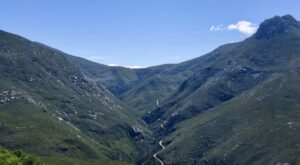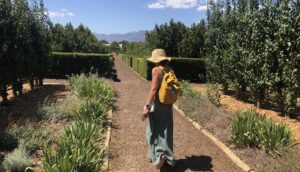In mid Feb we headed off on Amanda’s planned diverse five day road trip.
An hour’s drive from Knysna the Outeniqua Pass climbs over the mountains above the town of George, on the Garden Route. The pass was originally created in 1847 (and known as the Montagu Pass), as a trade route inland from the coast, for horses and wagons. It was one of those hard-to-comprehend projects that took a significant toll. It has since been re-routed, re-built and re-named as technology, machinery and vehicles have evolved. After driving back and forth along the N2 (between the mountains and the coast) several times it was exciting to head into a landscape that had only been a dramatic backdrop until then.

We’re going to run out of superlatives if not careful, so let’s just say the pass has steep, lush, green and rocky slopes (a bit like Scotland on steroids) with huge views down over George at the foot and on towards the Indian Ocean. It’s often shrouded in the clouds but we lucked out with a crystal clear conditions.
The pass leads into the Karoo – a sort of cross between desert and rocky flatland pastures. The Karoo is hotter and drier than the coastal areas – over 30°C when we were there, with huge plains and red rocks. In the Outeniqua region the Karoo is also home to ostrich farms on, of course, another grand scale. Ostrich generated wealth through their meat, leather and, it now seems… monster feather dusters. Locals sell them on street corners in the ostrich capital Oudshoorn and we wanted one, but it would be a touch unecessary on a catamaran.

Next stop was the spectacular limestone Cango Caves – one of the world’s longest and largest cave systems and it’s best to let the photos do most of the talking. The stalactites and stalagmites have formed over millions of years and, of course, in caves they’re not subject to erosion or other degradation. Standing next to these incredible formations, in cathedral sized galleries, put us and our lifespans into perspective.

From the caves we drove along Route 62 which, like Route 66 in the States, has its own T-shirts, mugs and tea towels. It’s justifiably renowned. The best stretch came the following day, so we’ll jump to our first night’s stay.
Amanda had found a converted old, seriously rustic barn on an olive farm in the middle of… nowhere. Let’s hope Avis don’t read this blog because off-road use of the car was banned (how’s that ever going to work in Africa?). By the time we tracked down our barn the car was an indistinguishable dusty lump. Mountains towered above the barn on one side, with huge views over the karoo on the other. Utter silence. We wandered around the olive trees, cooked a braai (South Africans tend to burn wood rather than charcoal, so you have to light it long before you’re hungry) and lay on stone benches gazing at the stars. Should have booked a week.



Next morning, after more dust and ruts, we re-joined Route 62 for one of the most epically breath-taking road trips we’ve ever done. Our photos just don’t cut it. It’s the size. Mountains on both sides, plains between, with the undulating road stretching, often ruler-straight, into the distance. Then, winding through another pass with a valley dropping away from one side of the road and a mountainside blocking the sky on the other. A scale you can’t really figure because there’s just nothing to give it perspective. Welcome to South Africa.
Eventually, Route 62 leads into the famous winelands, a hundred kilometres east of Cape Town and a complete change of scene from the olive farm. Names like Stellenbosch and Graeme Beck appear on signposts. Things become manicured and grand.
We were heading for one of the poshest wine farms (translates to vineyard), Babylonstoren, also boasting notable gardens that Monty Don travelled from the UK to film. Our wine-pro friends, Red and Helen, will testify that we’re not knowledgeable on this subject. And it was cooking hot – close to 40°C – too hot for us to want to taste wine. Even garden-passionate Amanda struggled looking around in the heat. BUT… lunch, made only from produce grown on site, was memorable. Anyone who knows The Pig restaurants in the UK will get it… but equally, have no idea.



At the other end of the scale, just up the road, was Mitres Edge wine farm where we stayed that night. Our kind of place. Lola Nicholls, Mrs Mitres Edge, inherited it from her father, who owned several wine farms in the region. As the sole daughter she got the smallest farm (her brothers got the big ones) but was happy with that. She’s fully hands-on, doing everything with a few long-serving staff, producing wines under their own label and supplying grapes to some of the bigger names. Lola gave us a wine-tasting in her cellar and we left with a case for Rush’s bilge.
First job next day – find a car wash (and hence the car), before heading into Cape Town where there would be increased risk of Avis spies. Car washing is, of course, done by people not machines and we asked for a quick hose-off. Forty five minutes later, leathered and gleaming (just as well – with only 400km on the clock we had no-where to hide) and we were off again.
Call us sad but the first job in Cape Town was to check out the chandleries. Important intel for the post launch, personal tweak stage. We bumped into Clarence (electronics guru installing Rush’s systems) in the first one, shared some banter and were starting to feel like locals.
Then down to the waterfront where The Ocean Race (formerly Volvo Ocean Race) was due in the following day. We’d timed our trip accordingly. This edition’s small fleet were having a slow leg from the Cape Verde Islands down to Cape Town, with routing taking them down the Brazilian coast and as far south as the ice limit to pick up the SW winds across the South Atlantic, into Cape Town. The leg was already about five days longer than predicted, they’d had to ration food and another shut-down was expected on the final approach. That night, after 17 days of racing, the first four boats were within a few miles of each other with everything to play for (or lose) through fickle conditions approaching the coast. Nice.
We were confident there’d be people we’d know on-shore – race officials, media etc – and one of them would say “Come out on our RIB for the finish”. Absolutely none. But the finish was visible from the breakwater and we could enjoy the Cape Town atmosphere as they came in. Shore teams waited on the pontoons with fenders and burgers. Foiling IMOCAs are so cool up close and you could feel the emotions of the crews – relief and joy, or disappointment.


It rounded off our varied trip, ahead of the drive back to Knysna the following day. We won’t talk about passing a fuel station because, according to Martin, “we still have plenty”… followed an hour later by driving for miles, on fumes, at snail’s pace, in stony silence. All’s well that eventually…



